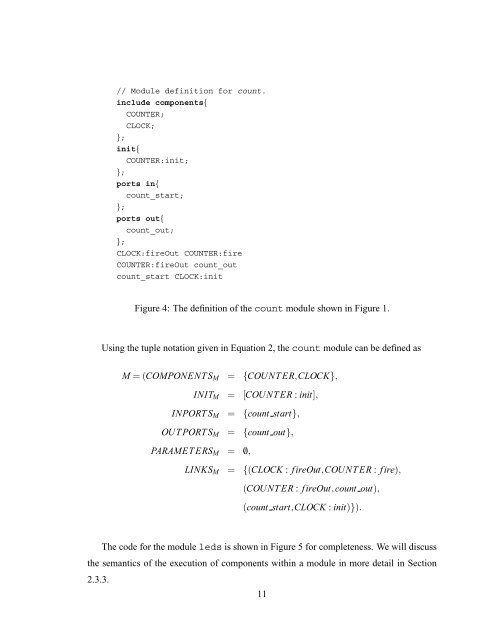Design and Implementation of TinyGALS: A Programming Model for ...
Design and Implementation of TinyGALS: A Programming Model for ...
Design and Implementation of TinyGALS: A Programming Model for ...
You also want an ePaper? Increase the reach of your titles
YUMPU automatically turns print PDFs into web optimized ePapers that Google loves.
Module definition <strong>for</strong> count.<br />
include components{<br />
COUNTER;<br />
CLOCK;<br />
};<br />
init{<br />
COUNTER:init;<br />
};<br />
ports in{<br />
count_start;<br />
};<br />
ports out{<br />
count_out;<br />
};<br />
CLOCK:fireOut COUNTER:fire<br />
COUNTER:fireOut count_out<br />
count_start CLOCK:init<br />
Figure 4: The definition <strong>of</strong> the count module shown in Figure 1.<br />
Using the tuple notation given in Equation 2, the count module can be defined as<br />
M = (COMPONENT SM = {COUNT ER,CLOCK},<br />
INITM = [COUNT ER : init],<br />
INPORT SM = {count start},<br />
OUT PORT SM = {count out},<br />
PARAMET ERSM = /0,<br />
LINKSM = {(CLOCK : f ireOut,COUNT ER : f ire),<br />
(COUNT ER : f ireOut,count out),<br />
(count start,CLOCK : init)}).<br />
The code <strong>for</strong> the module leds is shown in Figure 5 <strong>for</strong> completeness. We will discuss<br />
the semantics <strong>of</strong> the execution <strong>of</strong> components within a module in more detail in Section<br />
2.3.3.<br />
11
















